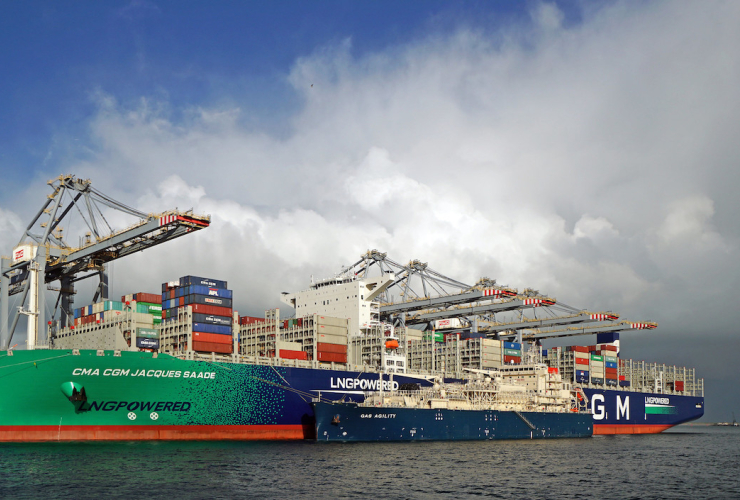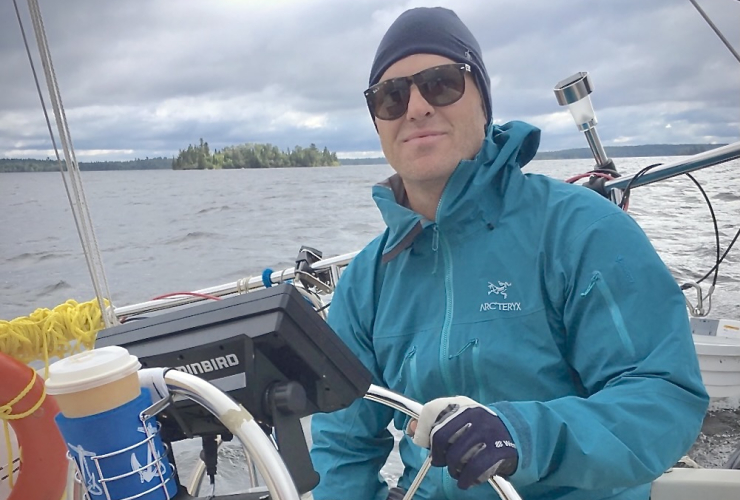Support journalism that lights the way through the climate crisis by June 3
Canada is getting cautious kudos with the launch of a blueprint for green marine transport and a new international agreement to create a zero-emissions shipping corridor on the West Coast.
Essentially zero-emission trade routes, green shipping corridors involve two or more ports that provide reliable access to emerging low-emission shipping fuels, like hydrogen ammonia and e-methanol.
These trade routes aim to reduce emissions from shipping activities, encouraging innovation in ship design and operations, scaling up the production and infrastructure of alternative fuels to displace oil and gas and the electrification of port operations.
However, the federal government’s newest green shipping channel and initial framework to fully decarbonize marine transport by 2050 doesn’t map out sufficient resources, its partners or any actual emissions targets or measures.
Transport Canada announced its awaited Green Shipping Corridor Program and $165 million to help decarbonize the marine sector along major routes on the Great Lakes, St. Lawrence Seaway and Canada’s east and west coasts during the recent UN climate summit, COP28, in Dubai.
Transport Minister Pablo Rodriguez also heralded Canada’s pledge at the summit to establish a West Green Shipping Corridor between ports on the B.C. coast and those in the United Arab Emirates, Korea and Japan. The plan also involves establishing at least six new green shipping routes by the middle of the decade.
Partners in the non-binding agreement include Indigenous groups, governments, ship owners, builders, shipbuilders, ports and terminal operators, rail companies, clean fuel producers and clean tech companies that recognize the urgency of fully decarbonizing the sector, Transport Canada said.
Canada is setting a course for a net-zero future, Rodriguez said in a statement.
“We are harnessing our collective will, investments, and momentum to ensure the global marine sector is secure, reliable, and sustainable,” the minister said.
Featuring the shortest route between North America and Asia — the route will extend from the ports of Prince Rupert and Vancouver to key ports in Asia and the Middle East, according to the memorandum of understanding (MOU).
However, the Port of Vancouver confirmed Tuesday that it is still in discussions about joining the initiative and did not clarify when that might occur.
It is also not clear what other partners are formally on board with the green shipping corridor given no signatories were listed in the MOU posted on Transport Canada’s website.
Repeated requests to the transport minister’s office and Transport Canada for information on the parties endorsing the green shipping route or a complete copy of the formal agreement went unanswered.
The Vancouver port has already taken some steps toward establishing green shipping initiatives, said Alex Munro, the port authority’s senior communications adviser, in an email.
It is collaborating on a feasibility study about a possible green cruise ship corridor along the Pacific Northwest to Alaska, Munro noted.
The Prince Rupert Port Authority (PRPA) has announced its involvement in the green shipping scheme.
The port is taking concrete action to address climate change and accelerate the transition to zero-emission solutions for port operations, said Shaun Stevenson, port authority president and CEO, in a statement.
“We are one of only two ports in Canada currently providing shore power to container vessels at berth and will continue to expand our capacity to meet our customers’ efforts to reduce their overall carbon footprint,” he said.
The port is also increasing the availability of alternative fuels and refuelling infrastructure, according to PRPA. However, the port authority did not reply to questions about the type of alternative fuels it is planning to advance or what new emissions initiatives are tied to the green corridor agreement.
The First Nations Climate Initiative (FNCI) and the Metalka First Nation have also announced they have signed onto the green shipping corridor.
The FNCI — which includes the Haisla, Nisga’a, Metlakatla, and Lax Kw’alaams First Nations — back the export of liquified natural gas (LNG) to displace coal in overseas markets as a pathway to transition to a net-zero economy while alleviating poverty in their communities.
The Haisla Nation is a major investor in Cedar LNG, a facility in development that includes a floating gas liquefaction plant and a shipping terminal in the Douglas Channel near Kitimat on B.C.’s north coast.
The B.C. government gave the project the environmental go-ahead in the spring saying it fits with the province’s climate targets and must be net zero by 2030.
The two federal announcements flag the federal government’s intention to decarbonize shipping, said Brent Dancey, marine climate action director for Oceans North.
“It’s good to see Canada taking initial steps to develop green shipping corridors,” Dancey said, stressing there is tremendous opportunity for Canada to lead the way in developing new zero-emission fuels, hydrogen hubs, and infrastructure on the coast.
However, there's a concerning lack of detail about how the agreement will actually “green” the shipping corridor, he said.
Additionally, the $165 million from the federal government’s green shipping program spread over seven years and across three different funding streams is wholly inadequate, he said. Research by Oceans North and other maritime groups estimates the cost to establish an e-methanol facility to meet shipping demand by 2040 would likely cost between $3 billion and $4 billion, he said.
Ambitious targets tied to a regulatory regime and much greater investment on the part of the federal government are urgently needed to drive innovation in the private sector, particularly by fuel producers, to reduce 80 per cent of emissions by 2040 and reach net zero around 2050 as mandated by the International Maritime Organization, Dancey said.
More than 80 per cent of world trade is moved by ships burning fossil fuels that spew out a billion tonnes of carbon dioxide annually. Maritime transport drives three per cent of the planet’s greenhouse gas emissions — roughly equivalent to all of Japan’s GHG emissions.
“At some point, there's going to have to be a serious discussion [in Canada] about funding and regulations that actually drive the achievement towards targets because this really isn't going to happen on a voluntary basis,” Dancey said.
Rochelle Baker / Local Journalism Initiative / Canada's National Observer
“At some point, there's going
“At some point, there's going to have to be a serious discussion [in Canada] about funding and regulations that actually drive the achievement towards targets because this really isn't going to happen on a voluntary basis,” Dancey said.
I'm curious if there have been any rumblings of a North American West Coast agreement on a common, "green", regulatory regime governing all shipping and port operations. it seems to me that Vancouver is at risk of shipping diverted to Seattle or farther south lest it jump ahead. Also, I wonder how much we wish to see Prince Rupert's port facilities (and Vancouver-Roberts Bank, for that matter) and land-side transportation (e.g. railroad) expand to support such "green" corridors.
What of adding costs to imports for embodied emissions, which had better be coming? It seems to me there must be some thinking underway to how supply chains may evolve to reduce full product lifecycle emissions and other ecological costs. How will that affect port facilities?
Etc. Etc. Etc.







Comments